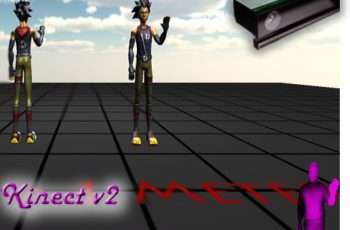
Detail this asset from Unity Store: Original Link
This is a paid asset, but now you can download Kinect v2 Examples with MS-SDK and Nuitrack SDK Free.
Kinect v2 Examples with MS-SDK v2.20 (Latest version)
Kinect v2 Examples with MS-SDK v2.19.2
This is a set of Kinect-v2 (aka ‘Kinect for Xbox One’) examples that use several major scripts, grouped in one folder. The package contains over thirty demo scenes.
Apart of the Kinect-v2 and v1 sensors, the K2-package supports Intel’s RealSense D400-series, as well as Orbbec Astra & Astra-Pro sensors via the Nuitrack body tracking SDK. Please mind that Nuitrack SDK is in early stage, and issues are possible.
Web | Forum | Twitter | Docs | Tips&Tricks
The avatar-demo scenes show how to utilize Kinect-controlled avatars in your scenes, gesture-demos – how to use programmatic or visual gestures, fitting room demos – how to create your own dressing room, overlay demos – how to overlay body parts with virtual objects, etc. You can find short descriptions of all demo-scenes in the K2-asset online documentation.
This package works with Kinect-v2, Kinect-v1 (aka Kinect for Xbox One & Kinect for Xbox 360), Intel RealSense D415 & D435, Orbbec Astra & Astra-Pro, and other Nuitrack supported sensors, as well. It can be used in all versions of Unity – Free, Plus & Pro.
How to Run the Demo Scenes:
1. (Kinect-v2) Download and install Kinect for Windows SDK v2.0. The download link is below.
2. (Kinect-v2) If you want to use Kinect speech recognition, download and install the Speech Platform Runtime, as well as EN-US (and other needed) language packs. The download links are below.
3. (Nuitrack or Orbbec) If you want to work with Nuitrack body tracking SDK, look at this tip. If you want to work with Orbbec Astra or Astra-Pro sensors via OpenNI2, look at this tip.
4. Import this package into new Unity project.
5. Open ‘File / Build settings’ and switch to ‘PC, Mac & Linux Standalone’, Target platform: ‘Windows’.
6. Make sure that ‘Direct3D11’ is the first option in the ‘Auto Graphics API for Windows’-list setting, in ‘Player Settings / Other Settings / Rendering’.
7. Open and run a demo scene of your choice, from a subfolder of ‘K2Examples/KinectDemos’-folder. The short descriptions of all demo scenes are available here.
* Kinect for Windows SDK v2.0 (Windows-only) can be found here.
* MS Speech Platform Runtime v11 can be downloaded here. Please install both x86 and x64 versions, to be on the safe side.
* Kinect for Windows SDK 2.0 language packs can be downloaded here.
One request:
My only request is NOT to share this package or its demo scenes in source form with others, or as part of public repositories, without my explicit consent.
Troubleshooting:
* If you get compilation errors like “Type `System.IO.FileInfo’ does not contain a definition for `Length’”, you need to set the build platform to ‘Windows standalone’. For more information look at this tip.
* If the Unity editor crashes, when you start demo-scenes with face-tracking components, look at this workaround tip.
* If the demo scene reports errors or remains in ‘Waiting for users’-state, make sure you have installed Kinect SDK 2.0, as well as the other needed components, and check if the sensor is connected.
* For other known issues, please look here.
Documentation, Tips & Tricks:
* The K2-asset online documentation is available here.
* Many Kinect-related tips, tricks and examples are available here.

